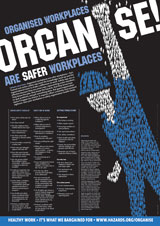
Our starting point should always be to remind ourselves that we are safety representatives. We do not represent ourselves; we represent the workforce. Whether by carrying out an inspection or a safety survey, sending out an email or holding a meeting – it is essential to actively consult the workers we claim to speak on behalf of.
Next, don’t go into any meeting with management unprepared. Do some research beforehand and if attending a safety committee always hold a pre-meeting with other reps to collectively agree your objectives.
If staff are concerned about the safety implications of proposed new technology, contact management in advance so that this item is near the top of the agenda, so it doesn’t get relegated to Any Other Business when everyone is looking at the clock.
 Prepare a list of key points you want to make, and when you’re in the meeting stick to the point and avoid wasting time by arguing over trivial issues that make no real difference to your members.
Prepare a list of key points you want to make, and when you’re in the meeting stick to the point and avoid wasting time by arguing over trivial issues that make no real difference to your members.
The purpose of meeting management is usually to convince an employer to implement measures that improve health and safety for workers. But how do we achieve this?
It’s important to explicitly ask for something. Union reps are often very good at telling the boss what is wrong with their risk assessments or that excessive workload is causing stress. That isn’t negotiating: it’s moaning. We must explain what the problem is, but also suggest what the solution should be.
I’ve always had a big mouth and the confidence to challenge managers whenever I thought they were asking us to do something that was unsafe. But take it from me that shouting at people, banging the table and sending all the papers flying into the air might look good on TV, but it’s a terrible negotiating style.
Presenting your argument with clarity and actively listening to the responses from management is much more professional. But it is not enough on its own.
Employers are seldom convinced to implement new safety measures purely based on the righteousness of our proposals, the robustness of our data or the union’s particular interpretation of legislation.
Retail workers regularly suffer physical and verbal abuse from customers. Employers even go onto the media to talk about it. Yet when union safety reps ask for more security guards in supermarkets, those requests are ignored time and again.
The United Nations has declared firefighting a carcinogenic occupation due to the excessive number of cancer related deaths amongst firefighters. A globally cited report commissioned by the Fire Brigades Union identifies contaminants that coat protective clothing after a fire as a major cause of the occupational cancers.
A straightforward control measure in relation to this identifiable hazard would be to install industrial washing machines in every fire station. The argument that this would improve long term health of firefighters is irrefutable. Yet retrofitting fire stations with these washing machines has been rejected on financial grounds by many brigades across the UK.
To put it bluntly, health and safety doesn’t sit in a magic box unaffected by budgets, deadlines and targets. When financial constraints take priority over workers’ safety, it will take more than a well-presented case and a good working relationship with management to improve workers’ safety.
Workers taking some form of collective action to tackle safety issues outside the safety committee is much more likely to move a stubborn employer to our way of thinking than a skilful turn of phrase inside a safety committee meeting.
That can only happen if the workers feel strongly about the safety issue and are confident enough to actively support their rep. And that goes right back to the start, and the need for safety reps to continually engage with the workers we represent.
REP PREP
At some point every safety rep is likely to find themselves sitting opposite a manager to discuss a health and safety issue. Whether it’s a safety committee meeting with someone from HR taking minutes or an informal chat, this can be daunting for a new rep. So, it’s useful to have a bit of a checklist for when we meet management.
| Hazards webpages | |
| • | Organising |
| • | Organising 101 |
| • | Union effect |




